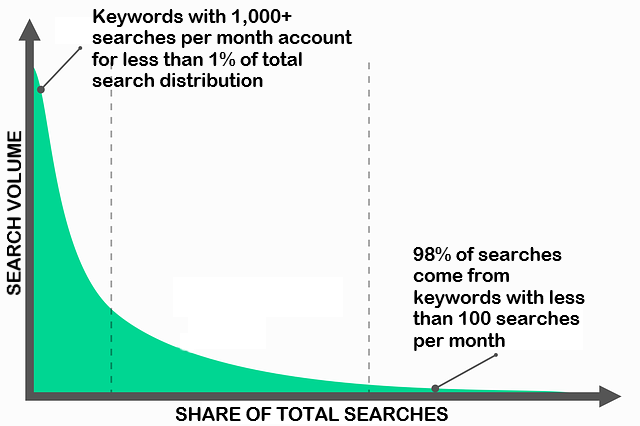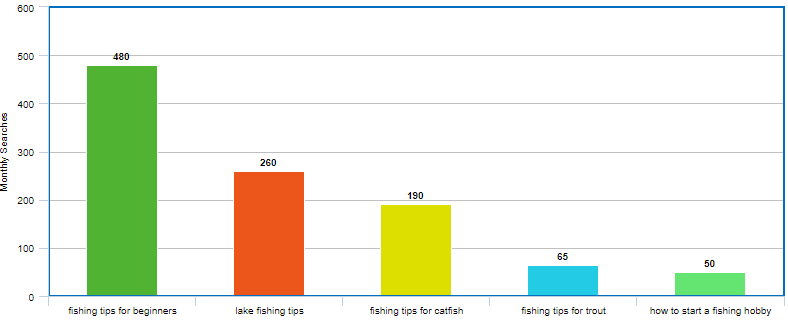Long Tail Keywords What Are They For and How Do We Use Them?
Keyword research is one of the first steps of any successful SEO campaign. One pitfall that a lot of people fall into, however, is focusing too much on the high competition keywords that are difficult to rank for due to their high keyword difficulty.
They get mesmerized by a high search volume, and fail to take into account just how hard it will be for their site to get in front of those 57,000 searchers every month. And they don’t even consider if the keyword suggests any sort of profitable intent from the searcher. Using tools that provide suggestions can help identify less competitive options.

These low hanging fruit are easy to compete for because most in search engine optimization (SEO) overlook them, and they generally convert better than shorter keywords. Brainstorming keyword ideas can help discover long tail keywords that target specific user queries. In this post, we’ll show you exactly why.
What Exactly Are Long Tail Keywords And How Do You Use Them?
Long tail keywords or LSI (latent semantic index) keywords are pretty much exactly what you would expect: keywords with more words in them; they have a “long tail”. Generally, at least 3, but it gets a little more nuanced than that.
Generating long tail keyword ideas can help identify specific phrases that target user queries.
You see, the term “long tail” is actually a reference to an analysis of the distribution of keyword searches. It turns out that the SEO keywords that get the most searches per month have the smallest total share of searches.

In fact, keywords with 1000 or more searches per month account for less than 1% of the total number of search engines results.
The long tail of the graph is that thin line composed of keywords with less than 100 searches per month. While these low volume phrases are generally not valued very highly in SEO, they account for 98% of the total share of internet searches.
To put that a little bit more simply, if there were only 100 people conducting searches on Google, 98 of them would be searching for longtail, low volume keywords.
Any given “head keyword” (the term for phrases with high search volume) is going to have its own search demand curve that mimics this pattern. For example, the broad keyword fishing tips (4,400 monthly searches) has any number of long tail keywords that decrease in search volume but still fall under the same topical umbrella:

Examples of Long Tail vs. Short Tail Keywords
For example, a short tail keyword like “shoes” gets a lot of searches but is also super competitive and vague. A long tail keyword like “best running shoes for flat feet” is more specific so easier to rank for and more likely to get users who are ready to buy.
This is Where Most SEOs Go Wrong in Keyword Research
The conventional keyword research wisdom in the SEO community is that the best approach to keyword research is to find keywords with high search volume and low competition.
The first problem with that is… those 2 things are rarely married. While not the case 100% of the time, often the very fact that keywords have a high search volume makes it an appealing target to people doing SEO and therefore more competitive.
It also does not take into account keyword intent. Using tools to find relevant keywords can help ensure that the keywords you target match user intent.
For example “gold” has 1.2 million searches per month… but it doesn’t give you any idea what the searcher is actually interested in.
However LSI keywords such as “Buy gold backed IRA accounts” “how to invest in gold” have dramatically less search volume, but actually have a clear purchasing intent and are therefore far more valuable.
Most SEOs would ignore keywords like this, but if you build out a website with a lot of easy to pick off long tail keywords yo can easily and build up a lot of warm – hot organic traffic that will lead to sales and you being able to brag to your friends about your SEO skills.
What Are The Benefits of Using Long Tail Keywords?
So, now you understand that long tail keywords are what most people are searching for on the internet. While individually, any LSI doesn’t account for very much search traffic, collectively they add up big time within a given niche.
Targeting topical long tail keywords can help improve search rankings and conversion rates by catering to specific search intents.
With that in mind, here are several of the benefits of using LSI.
1. Easier Rankings with Less Competition
Head terms like “shoes” or “marketing” are super hard to rank for because they’re so broad and competitive. Long-tail keywords like “best running shoes for flat feet women” have lower keyword difficulty (KD) scores so are more achievable for small to medium sized businesses.
For example:
“SEO” has a KD of 90% – impossible for newbies to compete with.
“SEO tools for small business 2024” has a KD of 25% – much easier to rank for.
2. Higher Conversion Rates
Long-tail keywords attract users with intent. Someone searching for “affordable marketing software for SaaS startups” is further along in the buyer’s journey than someone typing “marketing software”. These searchers are ready to buy.
3. Cheaper for PPC
Broad keywords have high cost-per-click (CPC) prices. Targeting niche long-tail terms gets you higher click-through rates (CTR) at a fraction of the cost.
Long Tail Keywords Have Strong User Intent
The reason for long tail keywords having such a large share of the search is because they account for the way people actually search for things online.
While millions of people might be interested in “auto repair” on any given day, most of them are searching for very specific things, like “how to fix a flat tire” or “how do I know if my car battery is dead”.
When you target LSI keywords, you can have a very clear idea of what your user is hoping to get from the results and direct your SEO content likewise. Long tail keywords tend to indicate a searcher’s readiness to make a purchase, leading to higher conversion rates.
For example, this post you are reading right now is targeting the term “long tail keywords for SEO”, which allows us to focus much more narrowly than a post that was targeting “keyword research” or “SEO strategy”, or even for “long tail keywords”.
Do Long Tail Keywords Convert Better?
Since long tail keywords predict a stronger intent from the user, that means they also convert better. In fact, web pages targeting long tail keywords convert at 26% on average, compared to just 10% for pages based around more general search terms.
It’s easy to understand why.
Someone searching for “shoes” or even “men’s shoes” doesn’t have the same level of commercial intent as someone who googles “business casual men’s sneakers”.
So targeting long tail keywords doesn’t just mean that you’ll have an easier time ranking. It also means there will be more value to the traffic you do bring in.
Will Long Tail Keywords Help You Rank For More Competitive Search Terms?
While those big volume head keywords might not convert as well, traffic is traffic. Eventually, they should be a long term goal within your SEO strategy. And long tail keywords are perfect for helping you move the needle on more competitive terms.
Google isn’t going to rank you for “personal finance” unless it thinks you’re an authority in the niche. The more you are bringing in traffic for terms like “budgeting tips for college students”, “how to save for a family vacation”, and “best apps for financial planning”—the more Google is going to recognize your site as an authoritative source.
How to Find Long Tail Keywords
Finding long-tail keywords requires a combination of keyword research tools and strategic thinking. Here are some effective steps to uncover these valuable search queries:
Use Keyword Research Tools: Tools like Google Keyword Planner, Ahrefs, and SEMrush are excellent for identify long-tail keywords. These tools provide insights into search volume, competition levels and keyword suggestions.
Analyze Search Volume and Competition: Look for these long keywords with lower search volume but also lower competition. These are often the sweet spots for them.
Explore Online Tools and Resources: Utilize various online tools and resources to find long-tail keywords related to your niche or industry. Forums, Q&A sites, and social media platforms can be goldmines for discovering what your audience is searching for.
Brainstorm Based on Your Offerings: Think about the specific products or services you offer and brainstorm long-tail keywords that potential customers might use to find them.
Leverage Social Media and Forums: Platforms like Reddit, Quora, and industry-specific forums can provide insights into the language and queries your target audience uses.
So How Do You Use Long Tail Keywords?
In the end, long tail keywords are the linchpin to a successful content marketing strategy. By focusing the keywords you research around low competition search terms with crystal clear user intent, you are going to rank more easily and drive more targeted traffic.
Using tools that provide keyword suggestions can help generate relevant keywords for content optimization.
They should drive your blog content. Behind all long tail keywords is a user looking for a specific type of information. The more you can create quality content that gives users what they need, the better chance you’ll have of ranking.
At the same time, you can also use them as ideas for what should go into a broader post. For example, if you are doing a mega skyscraper article on How to Train a Dog, you could include sections or sprinkle sentences targeting long tails that naturally fit, like these:
easy dog training strategies
tips for potty training puppies
how to train a dog not to bite
training a dog in an apartment
In other words, long tail keywords reveal user intent, and therefore form a solid base for the type of content you need to create.
Create Topic Clusters
Organizing your content into topic clusters is a powerful way to enhance both user experience and SEO. A topic cluster consists of a central “pillar” page that covers a broad topic and several supporting pages that delve into specific LSI keywords related to that topic. Here’s how to create effective topic clusters:
Identify a Broad Topic: Start with a broad topic or head term that is relevant to your niche.
Research Related Long-Tail Keywords: Use keyword tools to find long-tail keywords that are related to your broad topic.
Create a Pillar Page: Develop a comprehensive pillar page that covers the broad topic in detail. This page should serve as the central hub for your topic cluster.
Develop Supporting Pages: Create supporting pages that target specific long-tail keywords. These pages should link back to the pillar page, creating a cohesive cluster.
Interlink Your Content: Ensure that your supporting pages link to the pillar page and to each other where relevant. This interlinking helps search engines understand the relationship between your content pieces.
Optimizing for Long-Tail Keywords
Optimizing for long tail keywords involves more than just identifying them; it’s about strategically incorporating them into your website’s content. This includes using LSI in page titles, meta descriptions, headings, and body copy. Additionally, integrating these keywords into your internal linking structure and image alt tags can further enhance your SEO efforts.
Optimize Title Tags and Permalinks
Optimizing title tags and permalinks is a critical step in optimizing for long tail keywords. Title tags should include the primary long tail keyword and be both descriptive and attention-grabbing. For example, instead of a generic title like “Dog Training Tips,” a more optimized title would be “Effective Dog Training Tips for First-Time Owners.” Similarly, permalinks should include the primary long tail keyword and be easy to read, such as “yourwebsite.com/effective-dog-training-tips.”
By optimizing title tags and permalinks for long tail keywords, you can improve your website’s visibility and credibility in search engines. This can lead to increased organic traffic and conversions, ultimately boosting your revenue and profitability.
Use Long-Tail Keywords in Content
Incorporating long-tail keywords into your content is essential for targeting specific search queries and attracting relevant traffic. Here are some tips to effectively use them in your content:
Page Titles and Meta Descriptions: Include long-tail keywords in your page titles and meta descriptions to improve visibility in search engine results.
Headings and Subheadings: Use these long search queries in your headings and subheadings to structure your content and make it more scannable for readers.
Image Alt Tags and Descriptions: Optimize your images by including long-tail keywords in the alt tags and descriptions. This can help improve your content’s SEO and accessibility.
Internal Linking Structure: Use them in your internal links to create a logical flow of information and help search engines understand the context of your content.
Not All Long Tail Keywords are Created Equally
One thing to keep in mind is that just because a keyword has low search volume doesn’t necessarily mean it’s not competitive.
Targeting specific long tail keywords derived from internal site search queries and competitor analysis can improve SEO and drive targeted traffic.
Take the term “how to lose weight during pregnancy if obese”. This only gets 10 searches per month and seems like an incredibly narrow keyword. It should be easy to rank for, right?
Not when the first page of the SERPs includes sites like Healthline, ScienceDaily, and the Chicago Tribune—all with a domain authority in the 90s.
In this case, it’s because our keyword is really just a synonym for a more general search term. The same pages that rank for this one also rank for more competitive terms like “obese and pregnant” and “obese pregnancy”.
Use Them Strategically
Strategically using long-tail keywords can maximize their potential and improve your SEO efforts. Here are some strategies to consider:
Optimize Headings: Use them in your H2 and H3 headings to create semi-independent sections within your content. This helps both readers and search engines understand the structure of your content.
Add FAQ Sections: Incorporate FAQ or Q&A sections into your pages to target specific long-tail keywords. This can address common queries and improve user engagement.
Anchor Text Optimization: Use LSI keywords in the anchor text for internal and external links. This can enhance the relevance and authority of your linked content.
Content Marketing and Social Media: Integrate them into your content marketing and social media campaigns to reach a more targeted audience and drive relevant traffic to your site.
Monitor and Adjust
Monitoring and adjusting your long-tail keyword strategy is crucial to ensure its ongoing effectiveness. Here are some tips to keep your strategy on track:
Track Traffic and Conversions: Use analytics tools to monitor your website’s traffic and conversion rates. This data can help you understand the impact of your long-tail keywords.
Monitor Keyword Rankings: Keep an eye on your keyword rankings and adjust your content as needed to maintain or improve your positions.
Identify New Opportunities: Use keyword research tools to discover new long-tail keywords and opportunities. The search landscape is always evolving, so staying updated is key.
Adjust Content and Links: Regularly update your content and internal linking structure to target new long-tail keywords. This ensures that your site remains relevant and competitive.
Some Final Thoughts About Long Tail Keywords
So, as you go forward and start using your newfound knowledge of long tail keywords, just remember that not all long tails are created equally. You’ve got to evaluate the competition just like any other type of keyword research, and what long tail keywords are for.
Longtail keywords are a great way to target a more specific user intent, especially for E-commerce and affiliate websites. Check out the best affiliate marketing programs for beginners, if you haven’t quite chosen a niche yet.





